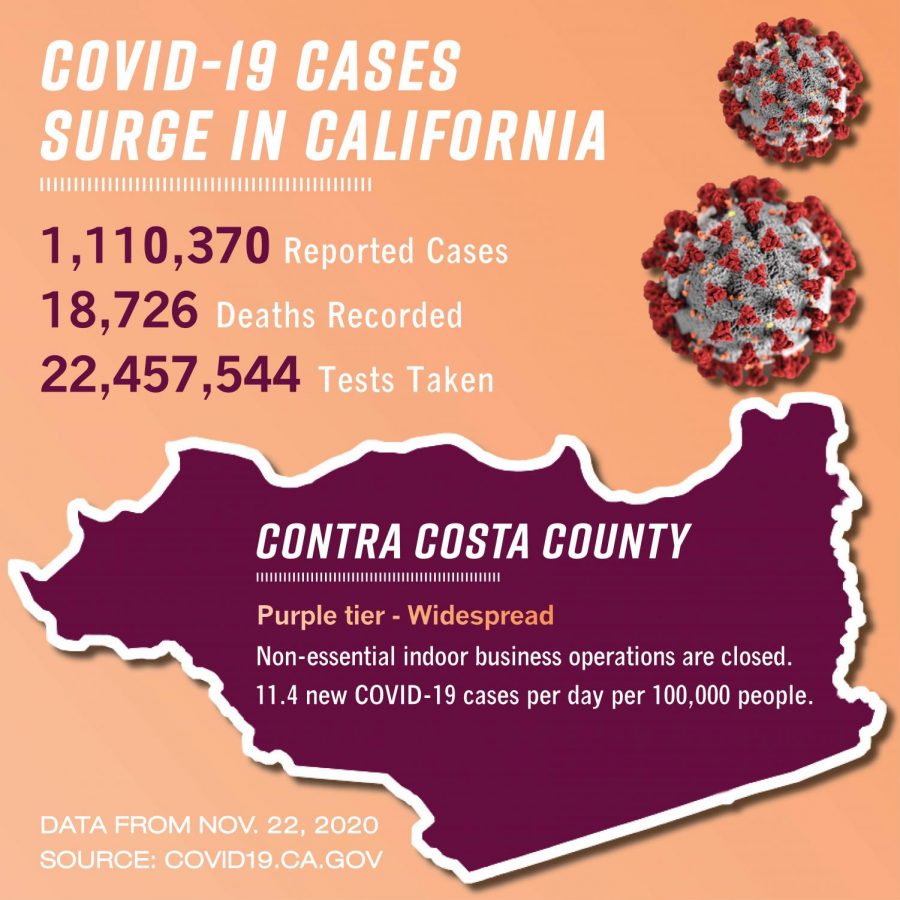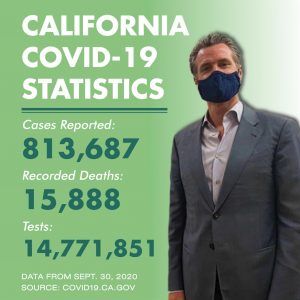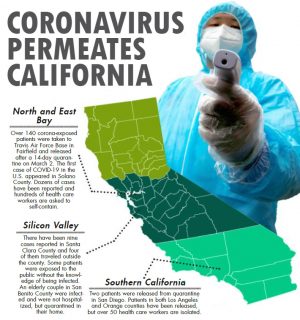COVID-19 update: Contra Costa County falls back to Purple Tier status
Daniel Hernandez / The Advocate
Contra Costa County is placed under purple tier restrictions as California faces a surge in COVID-19 cases. The latest statisctics come from the state of California from covid19.ca.gov.
Nov 24, 2020
The State of California is once again shutting down as California Governor Gavin Newsom announced a modified stay-at-home order on Nov. 19, affecting roughly 94% of the state as counties have fallen back into the purple tier due to an alarming rise of COVID-19 cases.
According to the State of California’s dedicated COVID-19 website, Contra Costa County saw 222 new cases Nov. 21. This coincides with the county’s 4.4% positivity rate over a 14-day average.
As of Nov. 21, Contra Costa County has seen 22,241 total cases of COVID-19. According to data acquired by the Los Angeles Times, the cities of Richmond, Antioch, Concord, and Pittsburg have seen the highest number of cases within the county. However, Richmond has seen the worst of it, with 4,112 confirmed cases.
The rest of California has not fared much better, as the state’s website is reporting over 1 million confirmed cases of COVID-19 and 18,726 deaths from the virus as of Nov. 22.
As a result, counties in the purple tier will be shutting down all non-essential businesses and instituting a curfew between 10 P.M. and 5 A.M.. The curfew went into effect Nov. 21 at 10 P.M.
However, people can still do a limited number of activities during that timeframe, such as going to the grocery store or drug store, walking your pets, and getting takeout from a restaurant.
The modified stay-at-home order includes a ban on activities with members of other households, and all activities done outside of one’s residence, lodging, or temporary accommodation with members of other households.
The order will not affect those facing homelessness or prevent anyone from the same residence, lodging, or temporary accommodation from leaving, as long as they are not engaging in any gatherings with people from other households, unless specifically permitted by the order.
This stay-at-home order is different from the original order that Gov. Newsom issued in mid-March, as it focuses on curbing late-night drinking and gatherings. At the time of publication, the order will last until Dec. 21; however, this is not a firm date and will be extended should new cases persist.
It should be noted, however, that the order will be enforced to varying degrees, depending on county. The Sacramento County’s Sheriff’s Office has chosen not to enforce the order, according to a prepared statement from Sacramento County Sheriff Scott Jones.
The San Jose Police Department has chosen to educate people rather than issue them a citation, according to its spokesperson.
Fresno County’s District Attorney Lisa A. Smittcamp told the Associated Press that “the order itself lacks direction regarding methods, specific statutes, and enforcement criteria, as to whether the governor intends to try to hold violators of this order accountable in criminal courts.”
Whether or not this order will be effective in combating the rising number of COVID-19 cases in California is yet to be seen, especially with Thanksgiving right around the corner and Christmas coming up within a few weeks.
For more information on the order, please visit the California State Department of Public Health’s FAQ page: https://www.cdph.ca.gov/Programs/CID/DCDC/Pages/COVID-19/limited-stay-at-home-order-qa.aspx






Don Casey • Nov 25, 2020 at 10:43 am
You may want to rethink the verb in your headline.
“at·tain
/əˈtān/
verb
succeed in achieving (something that one desires and has worked for).”
Maybe ‘regresses’?
“verb
3rd person present: regresses
/rəˈɡres/
1. return to a former or less developed state.”
Cindy Pantoja • Nov 25, 2020 at 4:15 pm
Don Casey
Thanks for the advice.
Claire Dobie • Nov 25, 2020 at 9:57 am
Hold on- you wrote “As a result, counties in the purple tier will be shutting down all non-essential businesses and instituting a curfew between 10 P.M. and 5 A.M.. The curfew went into effect Nov. 21 at 10 P.M.”
The curfew does not go into effect until Saturday, November 28.
Please correct.
Cindy Pantoja • Nov 25, 2020 at 4:11 pm
Claire Dobie
The State of California Health and Human Services Agency announced on Nov. 19 that his order shall take effect on November 21, 2020, at 10:00pm PST. https://www.cdph.ca.gov/Programs/CID/DCDC/Pages/COVID-19/limited-stay-at-home-order.aspx